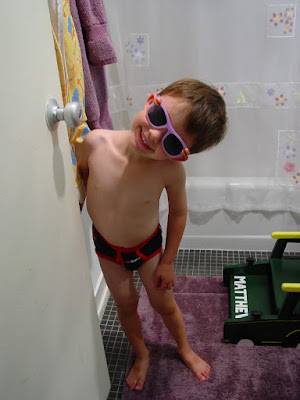Saturday, September 19, 2020
Tonight's picture was taken in September of 2005. As you can see Mattie (age 3) wanted to read books in our bed that night. Not an unusual request. Every night we read together, however, where we did it was up to Mattie. Mattie loved looking at the pictures in books and hearing stories told. He had many FAVORITE books, so much so that some books Peter and I could recite from heart!
Quote of the day: Today's coronavirus update from Johns Hopkins.
- number of people diagnosed with the virus: 6,755,171
- number of people who died from the virus: 199,082
This afternoon, Peter and I registered to attend our friend's virtual art fundraising party. In fact, I met my friend Ilona this week to pick up all the necessary supplies to participate in this Zoom party. I met Ilona and her husband in 2013, soon after their only child, Chris, died from cancer. One thing I can say is no two parents grieve the same way, and as such, interventions and strategies to deal with grief also differ by person.
If you asked me how I cope from day to day, I would say through writing the blog. Words matter to me and help me keep Mattie's memory alive, as well as give me an outlet to put my day, thoughts, and feelings somewhere. When I first wrote the blog, thousands of people read it daily. I could tell, as we have a number counter. However after Mattie died, the readership of the blog declined! My dad confronted me many times about wasting my time writing a blog that no one read. Of course I found both the decline in readers and my dad's comment hurtful. However, what I learned through TIME, was that the blog was for me. It was my outlet, my coping mechanism, and my way to talk about Mattie (as clearly I can't do this in my daily life). So while I write, my friend Ilona turns to art. She has taken many art classes and also became certified to teach intentional art classes.
After we walked Sunny around the National Mall today, I came home and set up our dining room table for the virtual art party. I wanted to have everything I needed around us, so that I could concentrate on what Ilona was telling us through the computer.This was my view while creating! Mattie's sun was my backdrop.
These are only some of Peter's creations. Peter is very artistic and unlike me, he knows how to draw and paint.
Ilona instructed us on several different watercolor techniques today. The instruction was about 90 minutes long. She talked about each painting style, then we saw her demonstrate the style, and after which we tried out each style using our own materials. The last 30 minutes of class was the intentional part. Where we could cut out things we painted, write on them, and form them in patterns.
When Mattie was in preschool, his name was "Mattie Moon." The school felt that children learned letters and the spelling of their names when matched with an object using the same first letter. Mattie Moon was so catchy, that many of us called him this for years to come.
Cut out watercolor paintings on top of an orange watercolor.
I am typically not a blue person. In fact, you will never see me wear blue or green. I like and appreciate these colors, but they aren't my favorites. In any case, I moved passed my comfort level and included blue in my design.
Naturally I couldn't do a creation without a butterfly included! Again the butterfly was cut out from a dot watercolor I did, and I placed it on this blue/purple spatter watercolor.
Mattie LOVED turtles. In fact, his preschool director adopted a sea turtle (Roxanne) for him when he was diagnosed with cancer. Roxanne had a tracker on her, and we logged in often when in the hospital to follow her where-a-bouts!


































